“Proper pest identification is very important, because if you don’t know what kind of pest you’re dealing with, it’s very difficult to come up with a successful management plan,” says Janet Hurley, school IPM extension program specialist with Texas AgriLife Extension Service.
Ants are a good example. Insecticide baits are available for many but not all species, and each bait product is effective for a limited list of species. With some types of ants, such as odorous house ants and carpenter ants, it is best to locate and treat the nest directly. In species such as pharaoh and Argentine ants, however, treating the nest with a spray like a pyrethroid can cause the ants to bud, or create multiple new colonies.
Hurley encourages IPM coordinators for school districts to have access to a microscope, jeweler’s loupe or high-powered magnifying glass during inspections. “Some schools have science labs with microscopes that IPM coordinators can use for pest identification,” says Hurley.
In many states, those who aren’t well-versed in pest identification can contact their county extension office. “Seasoned county agents should have some knowledge of pest identification,” says Hurley, “but those who don’t still have access to extension entomologists.” Most extension agencies are able to accept digital photos for identification, or pest samples can be sent in a vial or small container containing some rubbing alcohol or hand sanitizer. Websites such as bugwood.org or bugguide.net house libraries of insect images and make great aids for pest identification. Commercial identification services are also available, such as IdentifyUS, LLC, founded by Dr. Richard Pollack. IdentifyUS provides identification of both physical specimens and digital photos, as well as guidance on pest management.
Several pests that often get confused are bed bugs and bat bugs, blacklegged ticks and dog ticks, and common species of ants. Below is a brief guide to help with identification of these pests. If you are still unsure about what kind of insect you’re dealing with, always check with an extension agent, entomologist or other expert before taking action.
Bed Bug Cimex lectularius (Image credit Gary Alpert, Harvard University, Bugwood.org)
Bed bugs are broadly flattened, oval-shaped insects with greatly reduced wings. They are unable to fly or jump, but can move very quickly. They have segmented abdomens. They are light brown to reddish-brown in color before feeding, but become swollen and mahogany red after a blood meal. Eggs are white and newly hatched nymphs are translucent, becoming increasingly brown in color as they mature. Some individuals may exhibit skin rashes and other allergic reactions to bed bug bites, but not everyone exhibits symptoms after being bitten. Bed bugs typically leave small blood spots behind after feeding. Studies show that bed bugs can survive without feeding for up to a year, but they typically try to feed every five to ten days.
Western Bat Bug Cimex pilosellus (Image credit Susan Ellis, USDA APHIS PPQ, Bugwood.org)
Bat bugs feed primarily on the blood of bats, but will feed on other warm-blooded animals including humans if bats are not available. They will not become established on humans as a regular host. Bat bugs look very similar to bed bugs, possibly requiring microscopic examination to distinguish between them. A key difference is that the fringe hairs on the upper covering of the thorax (pronotum) are longer in the bed bug.
American Dog Tick (Wood Tick) Dermacentor variabilis (Image credit Susan Ellis, USDA APHIS PPQ, Bugwood.org)
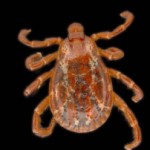
Dog ticks are predominantly found in the US east of the Rocky Mountains and are part of the family of ticks called hard ticks, which have a scutum or hard shield on their backs. Adults have eight legs and are brown to reddish-brown in color with a grayish scutum. Unfed males and females are about 3/16 of an inch long, and females grow to about ½ inch long after feeding, about the size of a small grape. They can be carriers of Rocky Mountain spotted fever. Nymphs feed on small rodents and adults prefer dogs or medium-sized mammals, including humans. They are most often found in the spring and early summer along animal paths in grassy, shrubby areas adjacent to wooded areas or forests.
Blacklegged Tick (Deer Tick) Ixodes scapularis (Image credit Scott Bauer, USDA ARS, Bugwood.org)
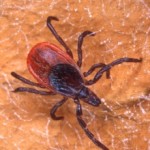 Blacklegged ticks are common in the northeastern and upper midwestern US and can be carriers of Lyme disease. They are also hard ticks. Unlike the dog tick, adult blacklegged ticks have no white markings on the scutum. They are about 1/10 of an inch long and dark brown to black in color. Females are often orange or red behind the scutum. Adults feed on large mammals, primarily white-tailed deer. Engorged ticks, or those that have had a blood meal, look significantly different from unengorged ticks, appearing swollen with a light grayish-blue colored abdomen. When identifying an engorged tick, it is helpful to focus on the legs and upper part of the body, which do not change upon feeding.
Blacklegged ticks are common in the northeastern and upper midwestern US and can be carriers of Lyme disease. They are also hard ticks. Unlike the dog tick, adult blacklegged ticks have no white markings on the scutum. They are about 1/10 of an inch long and dark brown to black in color. Females are often orange or red behind the scutum. Adults feed on large mammals, primarily white-tailed deer. Engorged ticks, or those that have had a blood meal, look significantly different from unengorged ticks, appearing swollen with a light grayish-blue colored abdomen. When identifying an engorged tick, it is helpful to focus on the legs and upper part of the body, which do not change upon feeding.
Argentine Ant Linepithema humile (Image credit Alex Wild, alexenderwild.com)
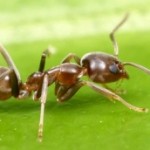 This is the most accomplished invasive species or “tramp” ant. It arrived in the US in the 1990s and is the predominant pest ant in California. It is also found along the Gulf Coast from Texas to Florida. Argentine ants have only one node (also called a petiole; a small bump between the thorax and the gaster, or abdomen), which is distinct but small and is never hidden by or fused with the abdomen. They are almost completely hairless, and are about 1/10 of an inch long. During the summer, multiple Argentine ant colonies may merge to form large supercolonies. They are monomorphic, meaning all ants within a colony are the same size.
This is the most accomplished invasive species or “tramp” ant. It arrived in the US in the 1990s and is the predominant pest ant in California. It is also found along the Gulf Coast from Texas to Florida. Argentine ants have only one node (also called a petiole; a small bump between the thorax and the gaster, or abdomen), which is distinct but small and is never hidden by or fused with the abdomen. They are almost completely hairless, and are about 1/10 of an inch long. During the summer, multiple Argentine ant colonies may merge to form large supercolonies. They are monomorphic, meaning all ants within a colony are the same size.
Black Carpenter Ant Camponotus pennsylvanicus (Image credit Susan Ellis, USDA APHIS PPQ, Bugwood.org)
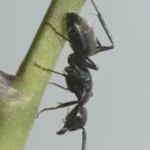 Carpenter ants have only one node and a tuft of hair at the tip of the gaster. The thorax, when viewed from the side, is evenly convex with no obvious bumps and ridges. They are generally large in size, ranging from ½ inch to more than ¾ inch long, and are polymorphic, meaning the colony includes several different sizes of ants that have different jobs. These include winged reproductive ants that overwinter and emerge in the spring. They prefer dead, damp wood in which to build nests, but they do not eat wood like termites.
Carpenter ants have only one node and a tuft of hair at the tip of the gaster. The thorax, when viewed from the side, is evenly convex with no obvious bumps and ridges. They are generally large in size, ranging from ½ inch to more than ¾ inch long, and are polymorphic, meaning the colony includes several different sizes of ants that have different jobs. These include winged reproductive ants that overwinter and emerge in the spring. They prefer dead, damp wood in which to build nests, but they do not eat wood like termites.
Fire Ant Solenopsis geminate (Image credit Pest and Diseases Image Library, Bugwood.org)
Fire ants have two nodes between the thorax and gaster. Their antennae are composed of ten segments, with the last two forming a distinct club. They have a visible stinger. They do not have any spines on their thorax. Thief ants have the same basic characteristics but are smaller, with fire ants greater than 1/10 inch long and thief ants less than 0.07 inches. Like carpenter ants, fire ants are polymorphic.
Pavement Ant Tetramorium caespitum (Image credit Joseph Berger, Bugwood.org)
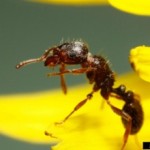 Pavement ants have two nodes, which are attached to the front of their abdomen rather than the top. They are dark brown or black in color and are about 1/10 of an inch long or slightly larger. They have distinct ridges on their face, which give a striped appearance, and no antennal club. They have a pair of small spines on the thorax close to the nodes.
Pavement ants have two nodes, which are attached to the front of their abdomen rather than the top. They are dark brown or black in color and are about 1/10 of an inch long or slightly larger. They have distinct ridges on their face, which give a striped appearance, and no antennal club. They have a pair of small spines on the thorax close to the nodes.
Article written by Jodi Schmitz, IPM Institute of North America
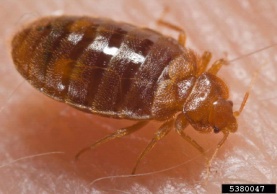

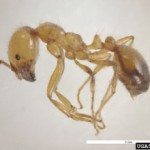

 .
.